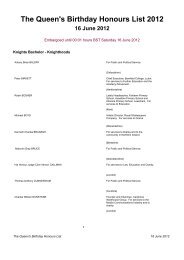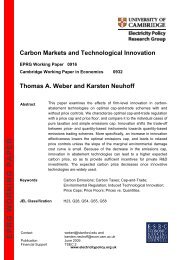EPRG WORKING PAPER - Electricity Policy Research Group
EPRG WORKING PAPER - Electricity Policy Research Group
EPRG WORKING PAPER - Electricity Policy Research Group
You also want an ePaper? Increase the reach of your titles
YUMPU automatically turns print PDFs into web optimized ePapers that Google loves.
vintages of the capital stock. Each vintage has its own energy e¢ ciency, which is a functionof input prices at the time of investment, and the exogenous technological change. In thisvintage capital model, rational cost-minimizing …rms choose both the optimal input quantitiesand the e¢ ciency of new capital stock. The model therefore is able to separate the‡exibility of substitution between input factors to production (labour, energy and materials),and the potential for more e¢ cient use of these inputs by choosing more e¢ cient technologiesat the time of investment.Steinbuks, Meshreky, and Neuho¤ (2009) estimate their econometric model for four sectors(agriculture, commerce, manufacturing, and transport) in 23 OECD countries between1990 and 2005. They …nd that vintage representation of capital stock signi…cantly improvesthe explanatory value of the model at the sector level. The results for all sectors indicate thatrising energy prices result in a substantial decline in long-run energy use, and a¤ect boththe operation (input substitution) and the investment (energy e¢ ciency of capital stock)components of energy demand. However, some of the estimated parameters cannot be reconciledwith the economic intuition. Interpretation of these results are plagued by exogenousstructural shifts within and across sectors, regulatory distortions, and measurement error.This paper attempts to evaluate the robustness of the results of Steinbuks, Meshreky, andNeuho¤ (2009) by applying their model to less aggregate data, thus reducing the distortionsfrom exogenous structural shifts and measurement errors. The model is estimated for …vemanufacturing industries in 19 OECD countries between 1990 and 2005. Our results con…rmthat including capital stock vintages signi…cantly improves the econometric model’s goodnessof …t. Estimated own-price elasticities of energy demand vary between 0.26 and 1.00 andare economically sound. Estimated own-price investment elasticities of energy e¢ ciency ofcapital stock vary between 0.03 and 0.9. This result indicates that the investment responseto energy prices varies signi…cantly across manufacturing industries, being signi…cant in someand negligible in others.An important …nding of this paper is that energy and climate policies aimed at reductionsin fossil fuel emissions can result in a substantial reduction of energy use in energy intensivesectors. The results of policy simulations for the U.K. petrochemical industry (the mostenergy-intensive industry in the sample) indicate that a 17 percent increase in energy pricesfrom a 30 dollar carbon tax results in a 19 percent decline in energy use. That is total(operational and investment) own-price elasticity of energy demand is close to one.The rest of this paper is structured as follows. The second section outlines the vintagecapital model and resulting stochastic speci…cation. The third section describes thedataset. The fourth section presents the main …ndings of the research. The …fth sectionpresents the results of policy simulations. The …nal section concludes, and suggests policy2






